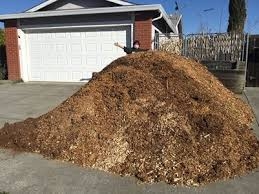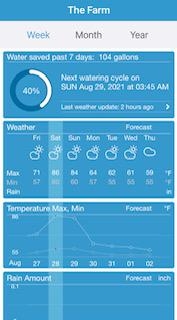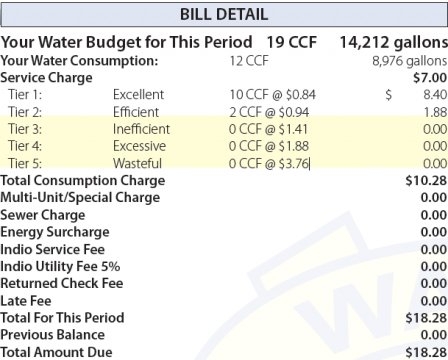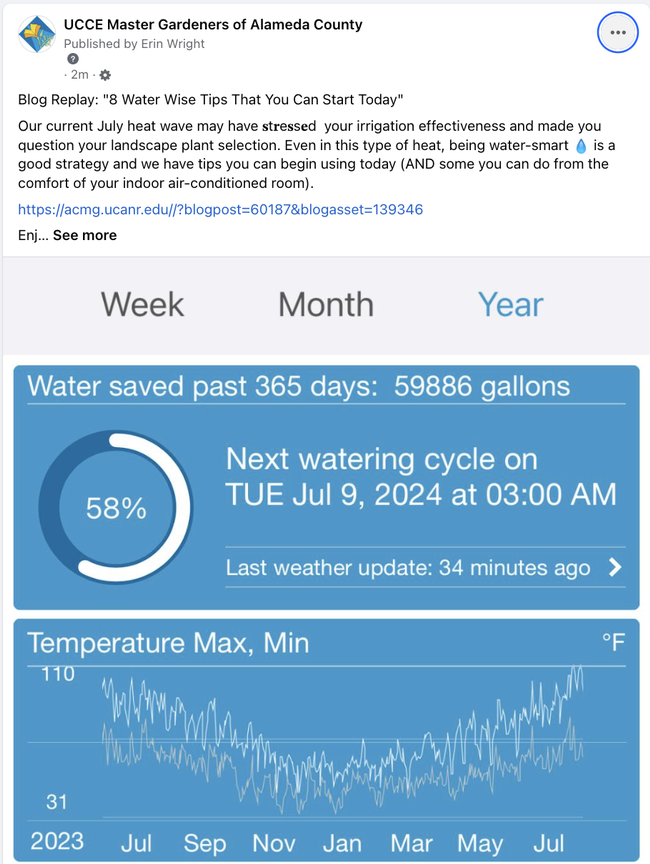(Editor Note: This blog first appeared in August, 2021 - it has been slightly modified for our current heat wave in July 2024)
This current July heat wave may have stressed your irrigation effectiveness and made you question your landscape plant selection. Even in this type of heat, being water-smart is a good strategy and we have tips that you can begin using today.
According to a University of California Report, residential landscape irrigation is estimated to account for about 50% of annual residential water consumption in California. While that amount varies widely from about 30% in many coastal communities to 60% or more in various inland suburban communities, bottom line, that is a lot of water.
So what can you do right now to save water and make a difference? You might be surprised by the steps you can take immediately that do not take much time or cost and will make a noticeable difference in your water usage. These steps apply to container gardening as well as in-ground landscaping. Some references specific to container gardening are given at the end of the article.
Where to Begin Saving Water In Your Garden
Tip One: Find Out How Much Water Your Landscape is Using
This will give you a benchmark to measure the impact of your water-saving efforts which will help encourage and motivate you as you see the things you are doing are really making a difference.
Measuring your landscape water usage can be a little difficult but there are ways to do it without spending a lot of time with paper and pencil.
If your city subscribes to Aquahawk your task is simple. Aquahawk is an online tool that can measure real-time water usage and makes figuring out your water usage as simple as logging in with your id and password. Unfortunately, only a handful of cities (mostly in the Tri-Valley) have access to Aquahawk.
If you don't have Aquahawk, then another way to estimate water usage is to pull up your water bills (hard copy or get online) and review your historic water usage. Assuming your landscape watering is minimal in winter, compare average water use in winter with average water use in the summer months. Given that other habits remain relatively constant, like washing dishes, laundry, showers, toilet flushes etc. then the difference will be primarily the water you are using for your landscape.
The Center for Landscape and Horticulture offer several online water calculators but these can be a little daunting to work through.
Now that you know your water usage, let's see how you can start to save water.
Tip Two: Mulch, Mulch, Mulch  Mulch mulch mulch
Mulch mulch mulch

This cannot be emphasized enough. Mulching has been described as the gardener's best friend and this is not an exaggeration. Imagine being able to minimize water usage by helping to slow down evaporation, reduce maintenance and weeds. In addition, cool the temperature of the soil and improve soil quality and fertility and even improve the look of your landscape! This is the magic of mulch. Mulching works for soils in raised beds and containers too.
What is mulch? Mulch is any material that is put on the surface of the soil to prevent water evaporation. Typically it may be straw or alfalfa pellets, wood chips, barks or hulls, or organic yard waste such as leaves or grass clippings. Mulch can be obtained free from your yard by using leaves or grass clippings or purchased at any home garden store or nursery.
You can learn more about types of mulch from the Master Gardeners of Sonoma County. Here is a website that will give you everything you need to know to start mulching:
To be effective, pile mulch six to eight inches deep, tapering down to three inches deep near the stems or crowns of plants. Mulch should not touch the stems of plants but should be approximately 10 inches away.
Tip Three: Composting
While you are mulching, consider adding compost to the soil or your containers. Compost is essentially organic mulches that have broken down to the point where plants can uptake the nutrients. Composts are typically worked into the soil unlike mulches which are layered on top. Besides improving the quality of the soil, compost acts like a slow release fertilizer. This will minimize the amount of extra fertilizer you use saving both money and water because over fertilizing plants causes excessive growth which uses more water. Additionally, compost helps to retain water especially in sandy soils where there is very little retention of water.
Tip Four: Check Your Irrigation System
Another extremely important step in saving water and eliminating waste is to turn on your landscaping watering system and observe. Check for broken lines and drip emitters and if you are watering grass check that the sprayers are functioning and spraying where they are supposed to.
While you are checking irrigation sprayers and lines, see if any water goes onto the sidewalk and down the gutter. Water down the gutter is water wasted. If necessary adjust your sprayers and irrigation timers to avoid any runoff.
Tip Five: Adjust Irrigation Times
Another step that takes only a few minutes but can make a significant difference is to set irrigation timers to water only between the hours of 9 pm to 6 am. This will minimize evaporation from the daytime heat and will utilize the irrigation water much more efficiently.
When you do this, consider adjusting your run time down some. If you have been watering outside of these hours chances are very good that you will be able to shorten your run times for each station on the timer. Water dedicated to landscape can often be reduced by 20 to 40 percent because over irrigation is very common. Gradually reduce the amount of water applied over a few weeks - giving lawns, trees and plants time to adjust.
To measure if you are applying enough water, the surface of the soil should be dry between watering but slightly moist about 2 inches down. Use the finger test, put your finger in the soil down to the second knuckle and if the soil feels slightly moist but not damp and a little bit of the soil sticks to your finger, then you are applying the right amount of water.
Many people overwater their landscaping so cutting back may actually improve the health of your plants. The signs of overwatering or under-watering are similar so checking the soil is the best indicator of whether your plants are being over or under-watered.
Step Six: Consider Using Cycling and Soaking Settings on Your Irrigation Timer

Step Seven: Check Your Irrigation Frequently
After the initial check of the irrigation system, it is a good idea to check the system occasionally looking for any water that is going down the gutter or hitting the sidewalk. Sometimes water pressure changes slightly or sprayers get a little clogged and water goes where it is not intended even though they were fine a few weeks prior.
Step Eight: Consider Planting Drought-Tolerant Plants
Drought-tolerant plants are sometimes misunderstood, “drought tolerant” doesn't mean they look like desert plants but many drought-tolerant plants have a surprising amount of color, pleasant fragrance, attract beneficial insects, and some are even deer resistant. Remember to plant drought-tolerant plants in late Fall so they can take advantage of the winter rains. All new plants require more water to get established, even drought-tolerant plants.
There are a number of great resources for identifying drought-tolerant plants. Below are a few resources that are available by just a click away. One of my favorites is the Alameda County Outstanding Plant brochures which are available online.
I find these particularly helpful because the plants are narrowed down to the plants that are proven to grow well in Alameda County, most are drought-tolerant and are readily available at local nurseries. Because these are nice, compact lists of plants that fit onto one piece of paper, you can easily take them to a nursery and use them as a guide for choosing plants. Keep a copy in your car and you will never forget to bring the list to the garden store.
These are steps you can take right now that will save water and lower your watering bill without affecting the health of your plants. Most of these steps can be completed in under an hour and a few others can be a nice weekend project, such as mulching your garden. So start saving water now and you will be doing yourself and the state of California a very big favor!
Water Saving Tips References
Water Calculators
Water Use Research
University of California Urban Water Use Study
Drought-Tolerant Plant Selection
- Outstanding Plants for Alameda County
- UC Davis Arboretum All-Stars
- EBMUD Water Smart Plants
- Water Use Classification of Landscaping Species (WUCOLS) – Very comprehensive database with a great searching tool
Water Wise Tips for Container Gardens
- Self-Watering Containers - University of Maryland Extension
- Growing Vegetables in Containers - Master Gardeners of Contra Costa County (pdf document)
- Container Gardening 101 - Master Gardeners of Santa Clara County (pdf document)
Have a gardening question? We'll help. You can reach us by:
- Emailing acmg@ucanr.edu. Please include a photo of the problem, if you can, plus your name, phone number, city and a description of the problem.
- Using our online form.
- By phone, during our office hours, 10 am to noon Wednesday and 11 am to 1 pm Thursday: 510-670-5645. At other times, please leave a message and we'll return your call during our office hours.
- In person at our Hayward office, during our office hours, only by appointment.

